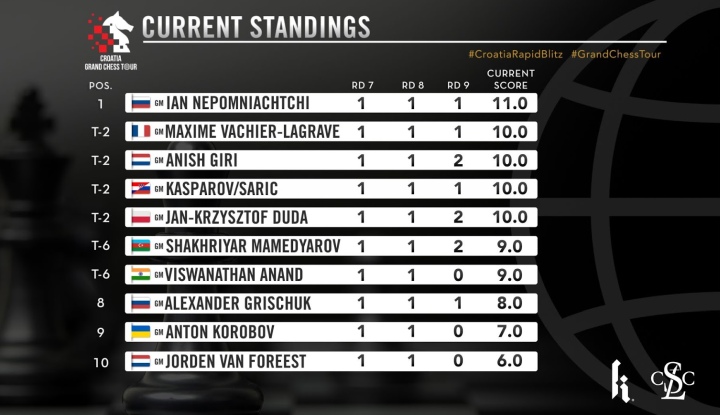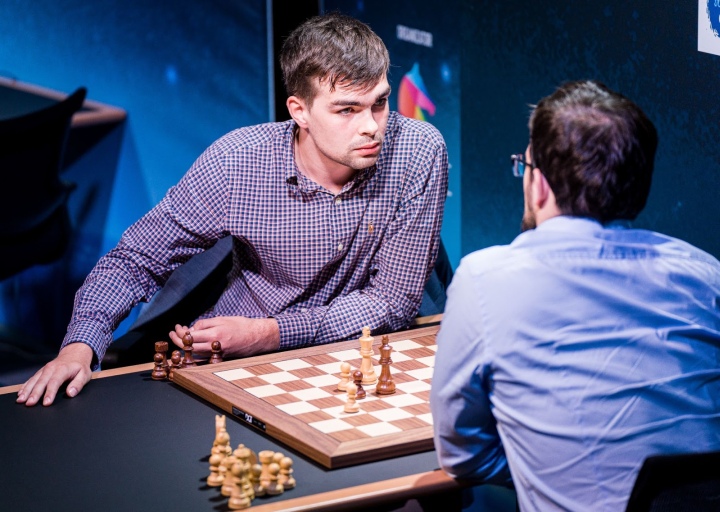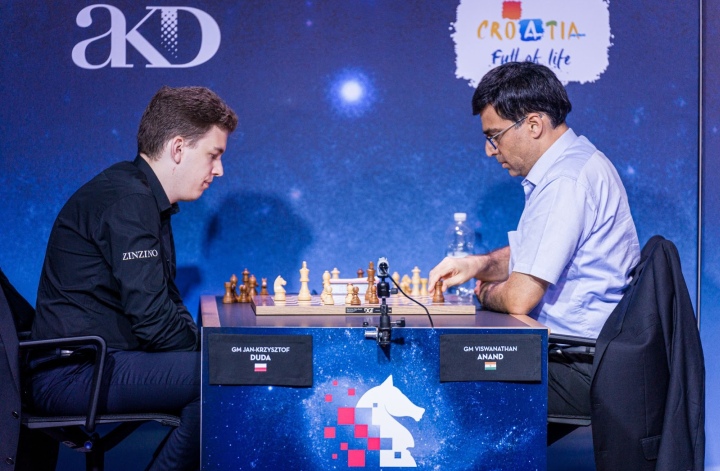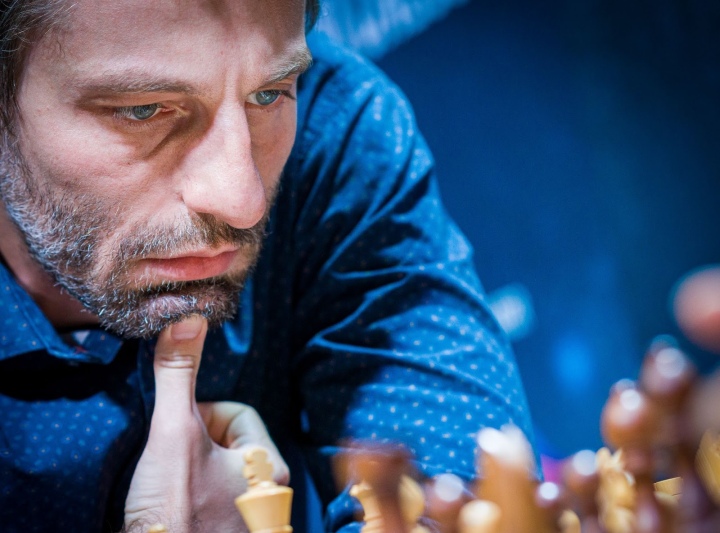Day three, and the last day of the rapid portion of the GCT Croatia Grand Chess Tour brought another dramatic day of chess. It may have seemed like a quiet day as there were only three decisive games. However, there were many hard-fought games with plenty of action making it a thrilling day of missed opportunities and excitement for the spectators.

Round 7
The first game to finish in round seven was between Ivan Saric against Shakhriyar Mamedyarov. They played a theoretical line of the Open Spanish where Black was able to equalize. Although activated his rook on the 7th rank, there was no way to continue putting pressure and the players agreed on a draw after a threefold repetition.
Although the Meran variation in the Semi-Slav is known to be a solid defense for Black, the game between Alexander Grischuk against Anton Korobov showed otherwise as Grischuk went for an e4-e5 push to take away Black’s king defender and tried focusing on a king-side attack. Despite a two-piece sacrifice 16. Nxe6 followed by 17. Bxg7, White didn’t have enough pieces in the attack, and the game ended in a perpetual.
The game between Anish Giri and Ian Nepomniachtchi was a highlight for the fans given the leader’s loss in yesterday’s last round. For many players, it is often difficult to come back after a tough loss, but Ian kept his calm. They opted for a Closed Catalan where most pieces got traded off into a rook and knight versus a rook and bishop endgame. Black had a passed d-pawn, but neither player had a way to make progress and the opponents agreed on a draw.

The talented Dutch Grandmaster Jorden Van Forest surprised the top French player Maxime Vachier-Lagrave with 10.h3N in the Najdorf Variation of the Sicillian (10. Be2 is a standard continuation in that position) and within the next few moves the position was certainly more favorable for White. When MVL tried the typical 22…d5 to equalize, he failed to realize that 23. Nc5! followed by the capture of his bishop in b7 and f4-e5 would have given White a huge advantage.
Jorden missed that opportunity and a few moves later went for greedy 26.exd5?? To win a pawn, he gave up the advantage after the beautiful 26…Nd3, which allowed Black to trade pieces into an equal endgame. The game didn’t end there though as the tables turned when White played 33. Re4? (instead of 33. d6) allowing Black to gain activity on the back rank. Black’s activity was so strong that the two-pawn deficit wasn’t even important. It seemed that MVL was in control and ready to convert, but Jorden fought until the end. He found a way to give up an exchange and ultimately created an unassailable fortress.
Another game that kept the viewers on the edge of their seats was the one between Jan-Krzysztof Duda and Viswanathan Anand. After getting an equal position from the Berlin Defense, Anand started pushing for the advantage. He attacked White’s center with f5 and upon being allowed to capture in e4 he found a way to trade into a better endgame with 30…Bxb4! giving up two pieces for a rook and two pawns. Although those pawns seemed menacing, White found a way to keep them from advancing. After trading a pair of rooks, Anand activated his remaining rook active and attack White’s pawn weaknesses on the other side of the board.

Unfortunately for Anand, there were several occasions where only moves were winning. His last miss was 65…h3??. He pushed the pawn too soon allowing White to trade his g-pawn for it and save the endgame. Instead, he had to give a few checks to push White’s king either back which would have allowed for his own king to advance, or forward which would have kept it away from the h-pawn. With little time on the clock, only the computer could have probably found the best continuation, so the game only ended in a draw.
Round 8
The first game to finish in round eight was the one between Ian Nepomniachtchi and Jorden Van Foreest. The opening choice of the Exchange Variation of the Slav suggested a quiet game, but Ian had some tricks up his sleeve and focused on the weakening of Black’s king-side with 10. f4 and a typical bishop sacrifice 17.Bxg6. Unfortunately for him, he did not have enough resources to continue the attack and had to concede a three-fold repetition.
The game between Anton Korobov and Maxime Vachier-Lagrave was a hard-fought duel in the Najdorf Sicilian, where Black gave up his a-pawn for piece activity. Despite the extra pawn, a bishop versus a knight and more space, White failed to find a way to push his majority on the queen-side without trading into a rook endgame. Once arrived in the rook endgame, Black kept his rook active and he was never in trouble to hold the game to a draw.
Anish Giri and Shakhriyar Mamedyarov played a theoretical line in the Gruenfeld Defense where many of the moves seemed forced to keep the balance. They traded into an opposite-color bishop endgame in which they agreed on a draw.
Viswanathan Anand had some positional advantage after the opening in his game against Ivan Saric. After 13…0-0 it seemed that White could have put some pressure on Black’s king with 14. Bh6 followed by Rae1 and some potential rook-lift as an attempt to keep the initiative and delay Black a little longer from the development of his bishop in c8. After 14. Qd4, Black was able to complete his development, trade his central weaknesses. The game was well played until the endgame where the players agreed on a draw in a rook and three pawn endgame on each side.

The most complicated game of the round was the encounter between Alexander Grischuk and Jan-Krzysztof Duda. The Najdorf Defense was the opening choice of these two players and after the end of the theory, White had the opportunity to win the b7-pawn, but chose not to do so. Instead, Grischuk went for 22. b3? That allowed the trading of the queens into an equal endgame. Black was able to trade his bad dark-square bishop and lend into a bishop rook versus knight rook endgame, where it was Black who had more active pieces. Black chose to take the bait and with White’s a-pawn, but allowed the opponent’s rook to get active on the back-rank and Grischuk forced repetition. Instead of 34…Rxa2?, Black could have waited for a few moves and tried to restrict White’s rook activity on the c-file with 34…Be8 or 34…Kh6 to make sure his king would escape the mating net it stayed on, which was precisely the idea used by Grischuk to draw the game.
Round 9
Round nine brought even more excitement as well as some decisive outcomes. The biggest turnaround of the day happened in the final round between Jan-Krzysztof Duda against Anton Korobov. The opening choice was the Saemisch Variation in the King’s Indian, which is known to lead to some sharp lines and decisive results depending on who gets to attack the other king first. On move 18, Duda made a huge mistake after which computers gave a decisive advantage to Black. Duda played 18. Nb1??, instead of the typical 18. Na4 which would have kept White’s king safer.
It was Black’s attack that seemed faster and with the a1-h8 diagonal opened many thought that Black was going to finish off his opponent soon. With his 21st move Black chose to complicate and open up the position with 21…d5?, instead 21…Nd7, which would have kept White from any king-side attack, while Black could take time to regroup and take advantage of White’s weak king. Though complications are generally good, they typically give the other side a chance to fight back and that is exactly what happened in the game. Duda captured Black’s knight in f6 and blocked Black’s piece “beast” – the bishop on h8 which would have normally created a lot of damage on the long diagonal. The last time Black could have kept his decisive advantage was with 27… Qb4+ followed by a rook trade and pressure on the b-file, which would have forced White to give up the queen and soon conceded the game.
Instead, Black played 27…Rb8 first, but now the pressure on the b file wouldn’t have worked anymore as White had sufficient defense with his two rooks. It was a few moments later that White was able to play 29. e5! turns Black’s bishop into a “big Pawn”, making it completely detached from where the action took place, and with his king safe and an extra piece, Duda was able to win the game.
The game between Ivan Saric and Alexander Grischuk was a clean game for the Berlin Defense. Saric was well in control throughout the entire game even sacrificing a pawn with 28. Nd5, but keeping a fortress, which Grischuk wasn’t able to break and they eventually agreed on a draw. This was certainly a fantastic overall performance by the wildcard and Croatian star Grandmaster Ivan Saric.
Ian Nepomniachtchi had a hard-fought game against Maxime Vachier-Lagrave. Though after the opening it seemed that the game was headed for a draw, it was MVL that made the first wrong maneuver. He brought his knight to be traded in e4, which allowed Black to put pressure on White’s weak pawns. A few moves later, Black captured White’s h-pawn and gain some advantage. It was on move 37 that Black mistakenly traded his passed and more advanced b-pawn for White’s a-pawn and with that gave his opponent a chance to create a fortress. Though Ian kept pushing, it wasn’t enough to break MVL’s defense and the game eventually ended in a draw.
Another tense battle was one between Jorden Van Forrest and Shakhriyar Mamedyarov. It was an Open Ruy Lopez that stayed equal for a very long time. Eventually, Mamedyarov pushed to attack on the king-side and was able to go into an unbalanced two rooks versus rook knight and bishop endgame, where the rooks proved to be more powerful. It seems that the young Dutch player was holding well, but in time scramble he failed to calculate the pawn promotions until the end and found himself in a position without an escape and had to concede the game.

The most dramatic result happened in the game between Anish Giri and Viswanathan Anand. The game was equal after the opening and though it seemed that it was Anand who was pressing with the control on the c-file and the bishop pair, he misplayed 28…Bxa3? instead of 28…Rd8, allowing White a very strong d-passed pawn. While trying to save a rook endgame, he found a good set-up to hold a fortress despite being two pawns down. Alas, he blundered with 47…Rc4?? instead of 47…Rc2 followed by hxg4 which would have given Black the opportunity to save the game. After the move of the game, Giri was able to create and support his f-passer and win the game shortly after.
The action continues today with the blitz portion of the event with the debut of Garry Kasparov replacing Ivan Saric in the 2021 Croatia Grand Chess Tour.
Text: WGM Sabina Foisor
Photo: Grand Chess Tour, Lennart Ootes
Official website: grandchesstour.org/







